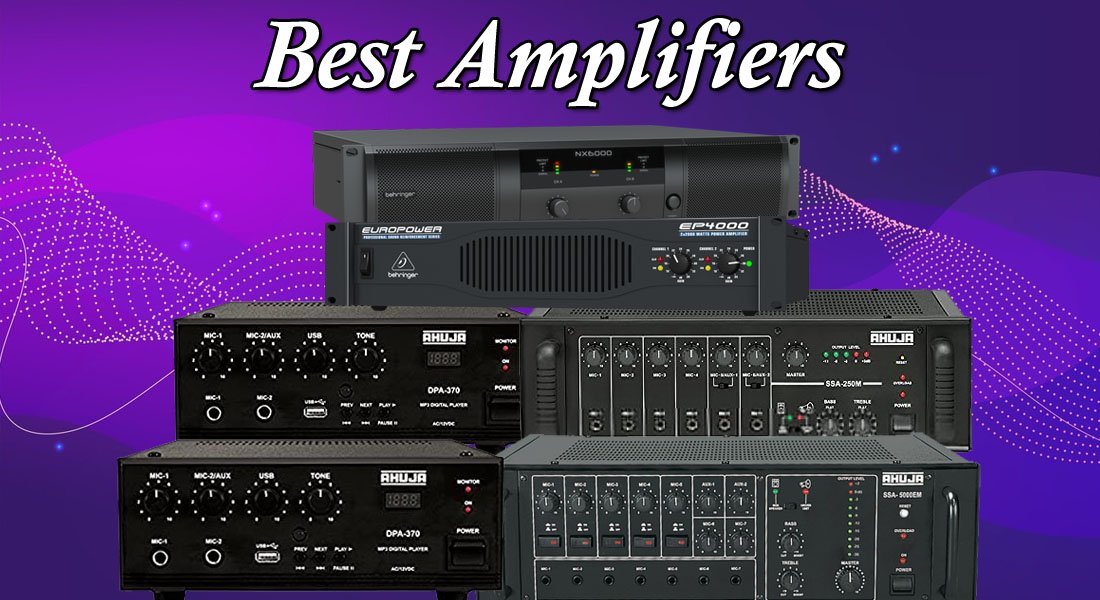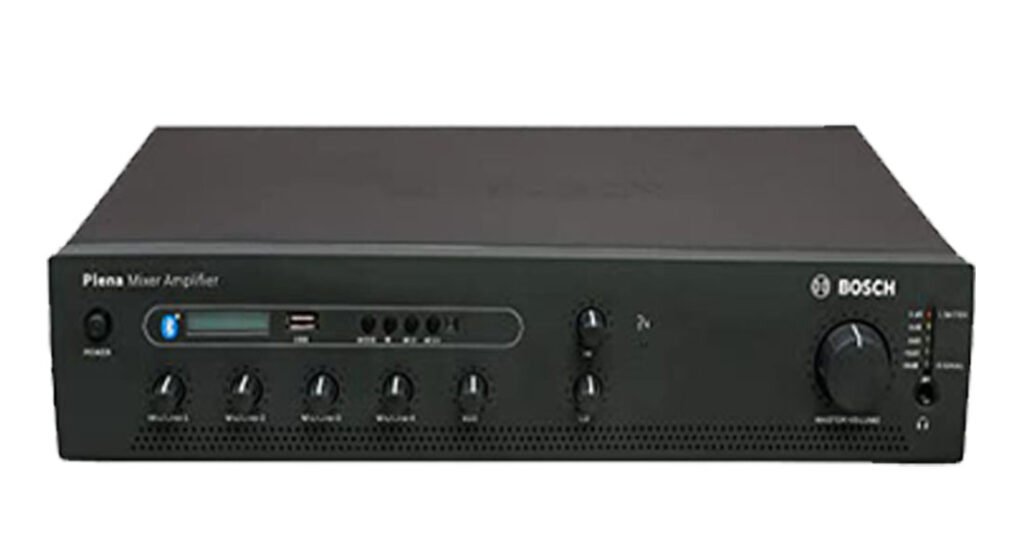
An electrical device that can boost the signal power, which is a time-varying current or voltage, is called an electronic amplifier, also known as an amp or amplifier. An amplifier is a two-port electrical circuit that uses the power from the supply to boost the signal amplification being supplied to the input terminals. It generates a signal at its output that is correspondingly stronger in amplitude.
The gain of an amplifier—which is the ratio of output voltage, power, or current—measures the amplification it produces. It is well known that amplifiers have power gains larger than one. An amplifier is primarily an electrical circuit that is housed inside of another piece of hardware or other machinery. Since amplifiers are utilised in many different types of electronic equipment, amplification is seen to be crucial for modern electronics.
An electronic component known as an amplifier responds to a variety of minor input signals, such as power, voltage, or current. It is renowned for producing big output signals that include waveform characteristics of the input signal. Electronic devices including television receivers, radios, computers, and high-fidelity audio equipment all employ various sorts of amplifiers.
Transformers, generators, and vacuum tubes are only a few examples of the electromechanical components that can perform the amplifying function. Most of the time, solid-state microcircuit amplifiers are used in electronic systems. An integrated circuit typically consists of a large number of transistors and devices connected to it on a compact silicon chip.
One amplifier has been found to be insufficient for boosting the output to the necessary levels. In situations like this, the first output feeds into the second, which feeds into the third, and so forth. Until the user receives an output that is satisfactory, this process is continued. A cascade or multistage amplification is the result of this. Now that you are aware of what an amplifier is, let’s examine some applications.
Uses of Amplifiers
Amplifiers are typically used in electric devices to provide varying levels of signal amplification. Most of the time, the signals are too tiny to drive or operate the desired equipment; in these cases, amplifiers are required. Let’s use an illustration to better grasp this. A speaker cannot be driven by the audio signal that is taken from records because it is too small.
Amplification is required in this situation to finish the job. Between the speaker and the needle of the record player, the signal is frequently amplified many times. The signal must go through an amplification stage before it can be amplified. A turntable and speaker system are connected by an audio amplifier, which often has several amplification stages.
A circuit called an amplifier, usually referred to as an operational amplifier, is frequently used to automate and regulate electrical circuits in a variety of nautical applications. The applied input signal is often a voltage or current signal. An amplifier’s goal is to produce an output signal that is stronger than the input signal.You can read also
You can read also: What is PA System Do I Need PA System?
An amplifier or op-function amp’s is to boost or amplify the input signal in order to provide or generate an output signal. These signals often have a waveform comparable to the input signals but are greater than the input signals. Most often, a rise in power level indicates a change in the output signal. It is well recognised for providing the extra power externally using D.C. voltage.
The input signal governs the output signals in an amplifier. Electronic components’ small-signal amplifiers are used as devices because of their capacity to boost weak input signals to stronger magnitudes. Let’s read about the different types of amplifiers now that we have learned what an amplifier is and how it is used.
Types of Amplifiers
Amplifiers are broken down into three groups based on the output-related characteristics. Voltage amplifiers, power amplifiers, and current amplifiers fall under these categories. The most frequent types of amplifiers seen in electronic equipment are voltage amplifiers. The voltage output of the signal is known to be amplified by these amplifiers.
The amplitude of the input current is increased by current amplifiers in comparison to the waveform of the input current. The power amplifiers are used to increase the power, which is defined as the output current and voltage multiplied by the input current and voltage multiplied by one another.
Even though the output current or voltage may be less than the input but is still greater than the input, Each time an AC signal is applied to the amplifier, a portion of the signal is amplified. The following categories can be further separated based on the signals that are amplified by the amplifiers.
We have a big form of Amplifiers with a view to choose from. Keep analyzing to see in case you need a Amplifiers, and what type is proper for you.
Intermediate Frequency Amplifiers
The devices that the amplifiers amplifies are known as Intermediate Frequency Amplifiers (I.F. These amplifiers are used in television, radar, and radio. They are renowned for amplifying radio, television, or radar signals at the highest voltage possible. This takes place before the signals’ audio or video data is demodulated.
Here, the operating frequency is less than the radio signal received. They are, however, stronger than the video or audio signals that the system eventually produces. Here, the equipment determines the frequency at which the I.F. amplifier must run.
Audio Frequency Amplifiers
The devices that magnify audio frequencies are known as A.F. amplifier or audio frequency amplifier. These audio frequencies are typically between 20 Hz and 20 kHz, while some HI-FI amplifier can go as high as 100 kHz.
These are used to provide the loudspeakers with the audio frequency power they need to operate. While initially constructed out of vacuum tubes, modern audio amplifier are primarily based on some solid-state drives like transistors.
Radio Frequency Amplifiers
The power of radio transmissions with low frequency can be increased using R.F. amplifier, also known as radio frequency amplifier. These are primarily employed for powering a transmitter’s antenna. These amplifier are the tuned ones, and the tuned circuit regulates their operating frequency.
In this case, the circuit can be modified based on the amplifier’s intended use. Here, both the input resistance and the gain are remarkably low. These amplifier are unique in that they produce little noise while performing. These are typically applied in the receiver’s initial stages.
It has been noted that the electronic device’s background noise is at a low level in this area. This occurs as a result of the amplifier’s ability to handle very low amplitude signals from the antenna.
Wideband Amplifiers
A band of frequencies can be amplified by these amplifier. They are renowned for their ability to amplify direct current up to many tens of MHz. These are utilised in a variety of devices, including oscilloscopes. They are utilised in applications where precise measuring signals dispersed across a wide range of frequencies are necessary. Their large bandwidth causes their gain to be modest.
Ultrasonic Amplifiers
The ultrasonic waves are amplified using ultrasonic amplifier. These are prevalent between the frequencies of 20 and 100 kHz. These are employed for certain tasks including ultrasonic cleaning, ultrasonic scanning, remote control systems, etc. Each of these categories has a reputation for functioning within a constrained range of ultrasonic frequencies.
Direct Coupled Amplifiers
Low-frequency signals are amplified using direct coupled amplifier, sometimes known as DC amplifier. In these amplifier, the output of one stage is typically connected with the input of the stage that follows. It is well known that these amplifier may amplify direct current frequencies, which are zero. Numerous measurement devices and electrical control systems primarily use them.
Buffer Amplifiers
In most cases, buffer amplifier are used to change the electrical impedance from one circuit to another. These have a one amplifier gain reputation. These are also employed in order to isolate circuits from one another. These are well recognised for having a greater input impedance level and a lower output impedance level.
Because of this, these can be used as an impedance matching device to show that there is no signal attenuation between circuits. This occurs when a circuit with a high output impedance feeds a signal to another circuit with a low output impedance.
Video Amplifiers
With the use of video amplifier, video signals can be of higher quality and are shown in higher resolution. The signals serve as a conduit for transmitting all of the picture-related data in radar and television systems. These could be categorised as a special variety of wideband amplifier used only for transmitting signals applied to video equipment.
Its bandwidth is based on the use of visual amplifier. These are wider in the case of radar receivers and stretch from 0Hz to 6MHz in the case of TV receivers. The signals that are received from computer monitors and DVDs are amplified using these amplifier. These can also be used to improve the video quality on tiny televisions fitted in vehicles that are smaller in size.
Operational Amplifiers
Operational amplifier are essentially high gain electrical voltage amplifie. These are used to manipulate voltages mathematically in a variety of ways. Furthermore, these are employed in the form of integrated circuits (ICs), which were first created using vacuum tubes. Two main input terminals are a feature of operational amplifiers.
These two terminals, which can be employed as inverting amplifier, summing amplifier, difference amplifier, and non-inverting amplifier, are inverting and non-inverting.
Transistor Amplifiers
Electronic components called transistors are employed as amplifier. These are renowned for enhancing the input signal’s current and voltage. Bipolar junction transistors (BJTs) and field effect transistors (FETs) are the two main categories of transistor devices.
In general, transistor amplifier are examined in a number of unique configurations. By employing BJR, these consist of a common emitter, base, and collector. These amplifier are examined under FET in the common gate, common source, and common drain configurations.
The current at the collector and emitter of the bipolar junction transistor may be controlled by a small current flowing through the terminal base. Field-effect transistors (FETs) allow for the control of the voltage at the source or drain by a small voltage applied to the gate.
Click Here For:- Audio Video Solutions
How Does an Amplifier Work?
It is not sufficient to understand what an amplifier is; you must also understand how it operates. Although stereo components are generally referred to as amplifiers, in actuality they are just a small portion of what they actually are.
They exist everywhere around us in the shape of computers, televisions, CD players, speakers, and other devices. An amplifier’s task is to create a new output signal from an input signal. The input circuit and the output circuit can be thought of as two distinct circuits.
With the help of the amplifier’s power supply, the output circuit is created. The battery or the power outlet are used to power this process. The power supply converts to direct current if the charge flow direction is the same and the amplifier is powered by the household AC current where the charge flow direction changes.
The electrical audio signal that is captured on the tapes and fed into the input circuit basically comes from a microphone. To replicate the original audio signals’ voltage swings, a variable resistance is provided to the output circuit. Amplifiers for authentic audio signals have a high type of load.
From Where You Can Buy Public Addressing System
Pasystem.in is the top Public Addressing System Provider in Delhi, which offers comprehensive PA solutions to institutions and business organizations and helps improve them in their day-to-day operations.
